Mooring of a floating unit to a vessel side
a floating unit and mooring technology, applied in the field of floating units, can solve the problems of large force and load, difficult to secure and fix the floatable unit in relation to the vessel, and difficulty in entering the floatable unit from the vessel
- Summary
- Abstract
- Description
- Claims
- Application Information
AI Technical Summary
Benefits of technology
Problems solved by technology
Method used
Image
Examples
Embodiment Construction
[0053]In the shown example the evacuation of the passengers or crew members takes place from the vessel by means of a chute, the evacuation from the vessel into the raft is independent of the mooring system, and may thus take place by means of a slide, a rope, ladders, jumps or in other ways.
[0054]The mooring system will be described in an embodiment, which in no way shall be considered as limiting for the invention.
[0055]In FIG. 1 the floatable unit 20 is shown, here in the form of an inflatable liferaft. According to the invention the floatable unit may also be a platform or a MOB-boat (man over board).
[0056]The floatable unit 20 has a first side 21 facing a vessel side 22 and a second side 23 facing away from the vessel side 22. The inflatable floatable unit 20 furthermore comprises a peripheral edge having two inflatable chambers 25, 26 surrounding a bottom (not shown) secured in leak tight fashion to the tubular inflatable chambers. The floating unit 20 also comprises a canopy ...
PUM
 Login to View More
Login to View More Abstract
Description
Claims
Application Information
 Login to View More
Login to View More - R&D
- Intellectual Property
- Life Sciences
- Materials
- Tech Scout
- Unparalleled Data Quality
- Higher Quality Content
- 60% Fewer Hallucinations
Browse by: Latest US Patents, China's latest patents, Technical Efficacy Thesaurus, Application Domain, Technology Topic, Popular Technical Reports.
© 2025 PatSnap. All rights reserved.Legal|Privacy policy|Modern Slavery Act Transparency Statement|Sitemap|About US| Contact US: help@patsnap.com



